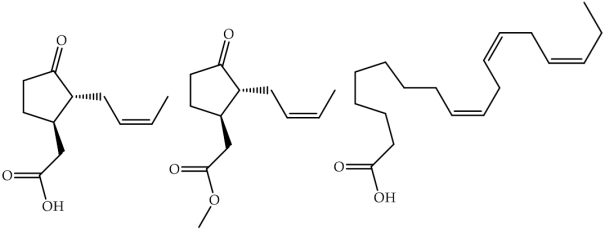When Plants Get Hormonal: Jasmonic Acid
Lipid synthesis is not always an end in itself. While lipids and fatty acids are undoubtedly useful in themselves – for the formation of biological membranes and as signalling molecules in biological systems – they can also be a raw material for other processes. One such process is the preparation of the hormone jasmonic acid in higher* plants [1].
Plants are often not thought of as hormonal organisms and, while this is true for the simplest plants, more sophisticated plant species are reliant on a number of processes for survival, including growth in relation to sunlight and temperature and reproduction. These processes can all be induced and controlled by the release of hormonal chemicals. Jasmonic acid, like cholesterol-derived testosterone in mammals, typically has a range of effects on the plant. Under normal circumstances, it forms part of the development of the plant, including flowering and the formation of fruit. Under stress, i.e., during a drought or after an injury, this hormone is part of the system that allows the plant to repair itself. But even that is not all. Jasmonic acid is volatile (will evaporate easily), as is its methyl ester derivative (Figure 1). The latter form, also found in plants and with similar activity to the acid, is also valuable in the perfume industry [2].
With such a variety of uses in higher plants (some of which are as important and quick as self-repair) speedy preparation of this hormone is required. It is perhaps therefore not surprising that the raw material used to make this hormone is plentiful. Plants use a fatty acid, called α-linolenic acid, to make jasmonic acid and its ester derivative (Figure 1) with the first stage of this process being the removal of the fatty acid from the membrane. This starts with an enzyme called lipase that cuts up lipids. In order for the hormone’s structure to be formed, oxidation is required to install a ketone and shortens the carbon chain from 18 carbons, to 10. As you might imagine, these processes require several steps and thus several enzymes.

Figure 1. Jasmonic acid (left) and methyl jasmonate (middle), the methyl ester of jasmonic acid. The raw material for biological preparation of this hormone, α-linolenic acid (right).
The fact that several steps are required is perhaps more useful than it may sound, not least to the process of evolution. It gives the opportunity for a huge range of mutations, and thus a huge range of changes and tunings of the system. Not only does it mean that there is scope for variations of these two signalling molecules, but also the receptors with which they react can be more or less sensitive. Perhaps not surprisingly, this has given rise to several related hormonal derivatives, such as jasmone [3]. This has led to an understanding of a variety of effects in plants, and lends growers a measure of control over the plants they cultivate.However, perhaps more elegant of all is the jump from the plant kingdom to the animal one. The relationship between plants and insects is well established, with several insect species playing a crucial role in pollination. Yet, in the case of a jasmonic acid derivative, it is the insects’ reproduction that is altered. The hormone jasmone (Figure 2) is produced by the insect, a weevil called Bruchus pisorum, but can be detected by the plant, a member of the pea family, in breathtakingly low concentrations. The plant is able to detect the hormone in what is known as the femto-molar range [4]. This means a limit of detection of 0•00000000000015 g of the hormone in 1 L of water. To put it another way, the plant can detect this hormone, and thus the presence of the insect, at a level at which 1 Kg of jasmone is dissolved in a volume of water twenty times that of the Indian Ocean.

Figure 2. The structure of jasmone, a hormone that can be detected by members of the pea family at very low concentrations.
The effect of this hormone is to induce cell division and a strengthening of the plant’s its fibrous tissue. This is something of a problem for the insect, as it means the larvae find it much more difficult to bite their way out of the plant’s tissue when they are fully grown [3]. So only the adult insects that produce both the larvae with the best eating action, and that emit the lowest amount of jasmone, are likely to survive. However if the plant has no defence against this invading insect, it too will die out and the insect species will follow shortly after. What is perhaps most exciting is that this indicates that the plant’s sensitivity to jasmone is helping to shape genetic changes in the insect population, and vice versa. Needless to say, the struggle is not over – it never is with evolution – but it remains to be seen what will happen in the next stage of the relationship between the predator and the prey with respect to this lipid-derived hormone.
References
*This is the name given to plants that have a more complicated structure, including sexed plants (angiosperms), and so applies to trees and flowering plants, but not algae.
[1] R. A. Creelman, J. E. Mullet, Proc. Natl. Acad. Sci., 1995, 92, 4114-4119.
[2] M. Hamberg, H. W. Gardner, Biochem. Biophys. Acta, 1992, 1165, 1–18.
[3] H. Weber, Trends Plant Sci., 2002, 7, 217–224.
[4] R. P. Doss, J. E. Oliver, W. M. Proebsting, S. W. Potter, S. R. Kuy, S. L. Clement, R. T. Williamson, J. R. Carney, E. D. DeVilbiss, Proc. Natl. Acad. Sci., 2000, 9, 6218-6223. http://www.pnas.org/content/97/11/6218.short